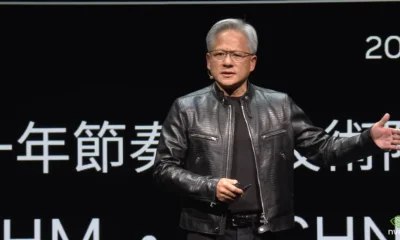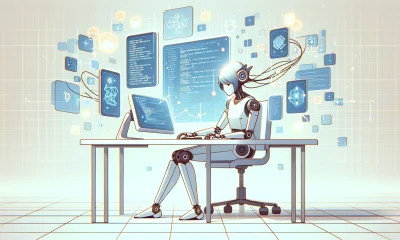Announcements
Breaking Down Nvidia’s Announcements at Computex Taipei

In a keynote brimming with electrifying revelations at the recent Computex Taipei conference, NVIDIA's CEO, Jensen Huang, officially took the wraps off of the Grace Hopper platform. This innovative combination of the energy-efficient Nvidia Grace CPU and the high-performance Nvidia H100 Tensor Core GPU signifies a new horizon in enterprise-level AI functionality.
Unveiling of Grace Hopper and DGX GH200
This comprehensive AI module was not the only remarkable announcement made by Huang. The DGX GH200, a powerful AI supercomputer, also took the limelight. Possessing extraordinary memory abilities, this behemoth of a supercomputer can house as many as 256 Nvidia Grace Hopper Superchips within a GPU the size of a typical data center.
The DGX GH200 truly is a powerhouse, delivering an exaflop of performance and boasting an impressive 144 terabytes of shared memory. This far outstrips its predecessor models by a factor of 500, opening the door for developers to construct complex language models for next-generation AI chatbots, craft advanced algorithms for recommender systems, and build sophisticated graph neural networks, vital for fraud detection and data analytics tasks. As Huang outlined, tech leaders like Google Cloud, Meta, and Microsoft have already started tapping into the capabilities of DGX GH200 to handle their generative AI workloads.
“DGX GH200 AI supercomputers incorporate Nvidia's most state-of-the-art accelerated computing and networking technologies, propelling the boundaries of AI,” Huang emphasized.
Nvidia Avatar Cloud Engine (ACE) for Game
In a major announcement that brought game developers into the spotlight, Huang disclosed the Nvidia Avatar Cloud Engine (ACE) for Games. This foundry service empowers developers to create and deploy bespoke AI models for speech, conversation, and animation. The ACE tool empowers non-playable characters with the ability to engage in conversation, thereby responding to queries with continually evolving lifelike personalities.
This robust toolkit comprises key AI foundation models, such as Nvidia Riva for speech detection and transcription, Nvidia NeMo for creating customized responses, and Nvidia Omniverse Audio2Face to animate these responses.
Nvidia and Microsoft's Collaborative Endeavors
The keynote also spotlighted Nvidia's new partnership with Microsoft to catalyze the dawn of generative AI on Windows PCs. This collaboration will develop improved tools, frameworks, and drivers to simplify the AI development and deployment process on PCs.
The collaborative endeavor will augment and expand the installed base of over 100 million PCs equipped with RTX GPUs featuring Tensor Cores. This enhancement promises to supercharge the performance of more than 400 AI-accelerated Windows applications and games.
Generative AI and Digital Advertising:
According to Huang, the potential of generative AI also extends to the realm of digital advertising. Nvidia has joined forces with WPP, a marketing services organization, to develop an innovative content engine on the Omniverse Cloud platform.
This engine connects creative teams with 3D design tools such as Adobe Substance 3D to create digital twins of client products within the Nvidia Omniverse. Through the use of GenAI tools, powered by Nvidia Picasso and trained on responsibly sourced data, these teams can now rapidly generate virtual sets. This revolutionary capability enables WPP's clients to produce a vast array of ads, videos, and 3D experiences, customized for global markets and accessible on any web device.
Digital Revolution in Manufacturing
One of Nvidia's primary focuses has been manufacturing, a colossal $46 trillion industry made up of around 10 million factories. Huang showcased how electronics manufacturers like Foxconn Industrial Internet, Innodisk, Pegatron, Quanta, and Wistron are harnessing Nvidia technologies. By adopting digital workflows, these companies are moving ever closer to the dream of fully digital smart factories.
“The world's largest industries create physical things. By building them digitally first, we can save billions,” Huang stated.
The integration of Omniverse and generative AI APIs has facilitated these companies to create bridges between design and manufacturing tools, constructing digital replicas of their factories – digital twins. Furthermore, they are utilizing Nvidia Isaac Sim to simulate and test robots and Nvidia Metropolis – a vision AI framework – for automated optical inspection. Nvidia's newest offering, Nvidia Metropolis for Factories, paves the way for the creation of custom quality-control systems, giving manufacturers a competitive edge and enabling them to develop cutting-edge AI applications.
Construction of Nvidia Helios and Introduction of Nvidia MG
In addition, Nvidia revealed the ongoing construction of the stunning AI supercomputer, Nvidia Helios. Expected to become operational later this year, Helios will leverage four interconnected DGX GH200 systems with Nvidia Quantum-2 InfiniBand networking, offering a bandwidth of up to 400Gb/s. This will dramatically boost data throughput for training large-scale AI models.
Complementing these groundbreaking developments, Nvidia introduced the Nvidia MGX, a modular reference architecture that allows system manufacturers to create a variety of server configurations tailored for AI, HPC, and Nvidia Omniverse applications cost-effectively and efficiently.
With the MGX architecture, manufacturers can develop standardized CPUs and accelerated servers using modular components. These configurations support a range of GPUs, CPUs, data processing units (DPUs), and network adapters, including x86 and Arm processors. MGX configurations can be housed in both air- and liquid-cooled chassis. Leading the charge in adopting the MGX designs are QCT and Supermicro, with other significant companies such as ASRock Rack, ASUS, GIGABYTE, and Pegatron expected to follow.
Revolutionizing 5G Infrastructure and Cloud Networking
Looking ahead, Huang announced a series of partnerships aimed at revolutionizing 5G infrastructure and cloud networking. One notable partnership with a Japanese telecom giant will leverage Nvidia's Grace Hopper and BlueField-3 DPUs within modular MGX systems to develop a distributed network of data centers.
By integrating Nvidia spectrum ethernet switches, the data centers will facilitate the precise timing required by the 5G protocol, leading to improved spectral efficiency and lower energy consumption. The platform holds potential for a wide range of applications, including autonomous driving, AI factories, augmented and virtual reality, computer vision, and digital twins.
Additionally, Huang unveiled the Nvidia Spectrum-X, a networking platform engineered to boost the performance and efficiency of ethernet-based AI clouds. By combining Spectrum-4 Ethernet switches with BlueField-3 DPUs and software, Spectrum-X offers a 1.7X increase in AI performance and power efficiency. Major system manufacturers, such as Dell Technologies, Lenovo, and Supermicro, are already providing Nvidia Spectrum-X, Spectrum-4 switches, and BlueField-3 DPUs.
Establishing Generative AI Supercomputing Center
Nvidia is also making massive strides in establishing generative AI supercomputing centers worldwide. Notably, the company is constructing Israel-1, a state-of-the-art supercomputer, within its local data center in Israel. This supercomputer aims to propel local research and development efforts.
And in Taiwan, two new supercomputers are currently under development: Taiwania 4 and Taipei-1. These additions promise to significantly boost local research and development initiatives, reinforcing Nvidia's commitment to advancing the frontiers of AI and supercomputing around the globe.














